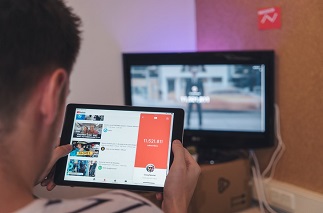Posts

Apomediation and Disintermediation: YouTube Prescribers on Fad Diets
As a result of the confinements of the COVID-19 pandemic and the sedentary lifestyle due to teleworking, there is an increase in weight gain and dietary carelessness in the population, which leads to an increase in offers of fad diets based on recommendations made by digital influencers. The aim of the study was to examine the characteristics of dietary recommendation videos made by non-health professional prescribers in Spanish and English to understand what patterns are followed by the productions of this type of content and what effects they have on the interaction they receive. An exploratory walkthrough method analysis was applied to define the variables of a codebook, followed by a content analysis of a sample of 50 videos published between January 2020 and July 2021. Most of the videos are published in the first months of the year, probably aimed at users seeking to reduce the weight gained during Christmas. The productions were characterized by having a very personal tone, informative and with relatively plural information, sometimes addressing the risks of diets or slimming products, and, although recommendations abound, the voices of experts are not frequent. The products and diets addressed in the videos often have a high health risk and do not involve practices recommended by experts, so although sometimes their contraindications or associated risks are pointed out, the promotional component and the search for traffic to the channel seem to be more relevant factors than public health in these videos.

Patterns and Actors of Disinformation: Analysis of Debunked Hoaxes in Spain in 2022
This research examines the patterns followed by disinformation in Spain through the fact-checking activities of Maldita.es, the leading fact-checking organization in Spain. We sought to answer three research questions: 1. What are the predominant topics of the hoaxes debunked by Maldita.es? 2. Who is responsible for the creation and dissemination of these hoaxes? and 3. In what formats and platforms are these hoaxes generally distributed? For this purpose, we conducted a quantitative content analysis of 729 hoaxes fact-checked in 2022 by Maldito Bulo. 40.7% of the debunked hoaxes were related to social issues, while 37.2% focused on political affairs. Regarding those responsible for the creation and dissemination, most of the hoaxes came from unidentified sources, although when the identity is known, the most frequent contributors are social media accounts, alternative and partisan pseudo-media, and journalists. These results explore the general disinformation scenario in Spain, using fact-checking as an approximation and discussing its implications.

Journalism on Forced Migration in Latin America: Recommendations from Experts and International Journalism Guides from a Qualitative Study
Wars, insurgent groups, dictatorships, and economic crises are the main reasons for forced migration. Displaced persons, asylum seekers, and refugees often face public stigmatization, as they are treated by the media as a social problem and, in many cases, seen as economic and social threats. This article presents the results of in-depth interviews with expert journalists and researchers from different Latin American countries on the phenomenon of forced migration and its journalistic coverage. Their recommendations are complemented by Qualitative Document Analysis (QDA) of international guides on migration journalism. The findings highlight the need for training and awareness-raising in critical skills and social analysis for journalists to understand the complexity of human mobility and approach it from a human rights perspective, as well as to project the positive contributions of migrants to the host society. Findings suggest the need to avoid disseminating and magnifying hate speech, which may be used to justify discrimination and violence against migrants. This highlights the fact that migration issues must be dealt with under slow journalism schemes, with an emphasis on research, thus avoiding falling into xenophobic discourse due to the very immediacy that the digital ecosystem demands.

‘Millennials and centennials’ perspective on Streaming narratives in Spain and Mexico: Spiral of silence, bandwagon effect, and third person effect
Viewers are increasingly used to the link between entertainment and technology in the current media ecosystem. The success of consuming streaming platforms when watching movies and series shows how the audience is more involved in new forms of viewing, at any time, at any moment, and with any content. This research aimed to examine the perception of millennial and centennial audiences in Spain and Mexico, the two Spanish-speaking countries with the highest streaming consumption, about audiovisual content producers for entertainment. Three theories on public perception (spiral of silence, bandwagon effect, and third-person effect) were used as the basis of the research questions to unravel the extent to which younger audiences in these countries consider that production companies are, or are not, ethical in the representation of what may be labeled as "sensitive topics". The results show that centennials are more confident in their critical perceptions of controversial issues in movies and series, while, on the other hand, millennials approach their perceptions with more cautiousness and confusion.

Girl YouTubers: Interaction, creation, and emotions during COVID-19 confinement
The COVID-19 pandemic forced absolute confinement in Spain from March 15 to July 21, 2020. On the other side of the screen, YouTubers girls and boys, creators of specific content for their peers, took the opportunity to increase their productions. This research examines 73 creations made during the confinement period by six Spanish girls YouTubers categorized as influencers by the number of reproductions and followers of their channel sthrough content analysis to evaluate the interactions, the content generated, and subjective aspects of projection of the emotional state of these minors. The results show increased interactors, positioning the female sector as the most prevalent gender. The contents have been related to the COVID-19 theme, while, in the emotional aspect, the influencers were not affected by the great sadness that hit Spain with the death of thousands of people.

How to Botox’ on YouTube: Influence and Beauty Procedures in the Era of User-Generated Content
The current media environment is complex and has important effects on all aspects of life, including beauty and health. In this sense, YouTube has become one of the main contexts for the dissemination of tutorials and content related to medical procedures such as the application of Botox. Thus, the present study constitutes the first exploratory analysis of YouTube videos in Spanish related to this procedure. A preliminary analysis of 221 YouTube videos yielded a final sample of the 50 most viewed videos within this genre. The analysis was carried out through a quantitative content analysis assessing the popularity of the videos, contact and emotive strategies by the creator, the credibility conveyed, and the characteristics of information about the procedure itself. Results suggest that these influencers align with mainstream Internet celebrity culture in practices that aim at increasing their following and views, as well as calls for subscriptions and visits to other platforms and profiles. Moreover, they include different strategies to establish their credibility but emphasize personal experience. The positive portrayal of the procedure, including positive emotions and content that highlights the benefits, is interesting and supports the commercial nature of much of the content.

Coworking spaces and virtual learning communities in social networks: Case Study of #ElClaustrodeIG on Instagram
Social networks are consolidated as spaces for the exchange of valuable content. It is not surprising to find spaces for the exchange of good teaching practices in virtual learning communities, so the objective of this study is to analyze, through the case study of #ElClaustrodeIG on Instagram, the educational content focused on teaching that is shared for the Ibero-American community in Spanish, as well as the analysis of the users who share their experiences and good practices in this social network. In order to do this, content analysis is first carried out, through an analysis sheet to 300 posts and a questionnaire is applied to 130 users of this hashtag on Instagram in order to analyze their patterns of use, their interests and motivations, their training in ICT and social networks, as well as the impact that the use of this social network has on their professional development and the gratification they expect. The results show that most of the publications are about good practices for primary and preschool education while most of the users think that Instagram is an ideal space for non-formal learning, applying in the classrooms many of the good practices shared in this coworking space.

The Demonization of Islam through Social Media: A Case Study of #Stopislam in Instagram
This article studies the process of demonization, its consequences, and how social media contribute to the formalization of its axiology. The demonization of societies aims to create social subjects that fit into the idea of the “other” by exposing them to compulsory invisibility. This research’s main objective was to examine how demonization is used as a weapon of oppression to devalue specific individuals through the hashtag #StopIslam and Instagram’s role in this process. The methodology used for this purpose has consisted of an empirical and quantitative analysis of the most recent (1 January 2020–31 July 2020) posts on Instagram with #StopIslam, analyzing the images and the content. The study has determined how, through social media manipulation, erroneous ideas are transmitted that prevent the Islamic collective’s integration, especially in European countries. The conclusions will reflect hate speech and how the Islamic world’s demonization results in the Muslim community’s stigmatization, racism, and Islamophobia. Although there are different articles related to demonization and hate speech, there are not many scientific resources that explain these variables on Instagram and how it affects the inclusion of the Muslim community in Europe, significantly when the time spent on the Internet is growing.

Kid influencers in Spain: understanding the themes they address and preteens’ engagement with their YouTube channels
This research analyses the contents of the videos of the ten Spanish children's YouTube channels with the highest number of followers and video plays to identify correlations between the thematic axes of the videos and the increase in digital engagement data. Little is known about the topics that the most popular Spanish-language YouTube influencers share with preteens and young adults' audience. In response, this exploratory study will use content analysis to examine this gap and contrast the themes that its videos reflect against others. For this purpose, interpretive-based content analysis is carried out based on an analysis sheet validated by expert judgment. Among the main results, it is shown that most of the children who are the lead character of the channel are currently between 10 and 12 years old, having created the channels an average of five years ago, which shows how early many YouTubers are starting in this industry. There are also differences in the thematic axes of the channels' videos according to the gender of the children's influencers, with a higher representation of male YouTubers devoted to gameplays, while their female peers have a more significant presence in videos in the lifestyle category. It is concluded that there is a need to supervise the contents accessed by children on this platform since it can deepen not only gender gaps but also become a wrong reference of role models.

Learning Leaders: Teachers or Youtubers? Participatory Culture and STEM Competencies in Italian Secondary School Students
Youth is increasingly learning in non-conventional contexts, such as social networks or video platforms, courses, and tutorials. This research aims to diagnose the role of participatory culture, digital resources, social networks, and, specifically, YouTube, in learning processes and the acquisition of Science, Technology, Engineering, and Mathematics (STEM) skills, specifically in mathematics, also analyzing the role of youtubers and, in contrast, teachers, both learning leaders in the formation of these skills. In order to accomplish this, mixed methods (quantitative and qualitative) were used, based on a survey applied to 4845 Italian adolescents, as well as a content analysis of the videos and YouTube channel of the Italian educational influencer Elia Bombardelli, one of the most followed and best rated in this country. Also, an in-depth interview has been applied to 12 Italian secondary school teachers. Among the main findings, it is highlighted that all adolescents value YouTube videos as a key resource to improve their school performance, rating youtubers better than teachers. However, it is remarkable that in the processes of learning and acquisition of STEM competencies, they prefer to interact with teachers rather than with youtubers.
